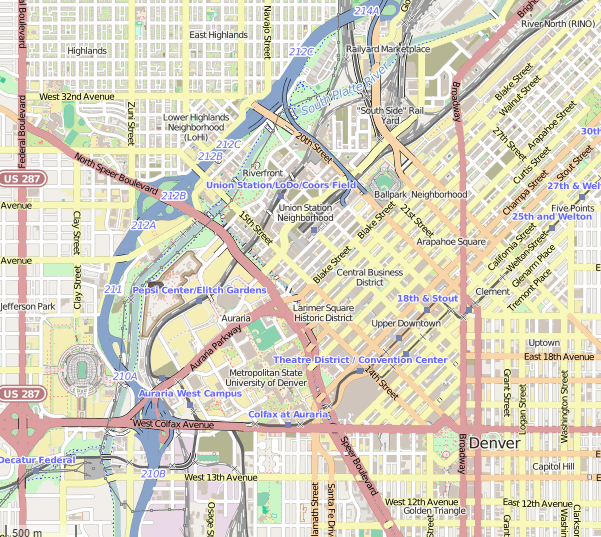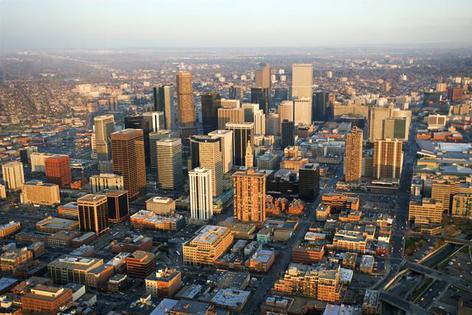Map: © OpenStreetMap contributors
Another Ed Sadowski creation
ED SADOWSKI
MUSEUMS
Airports...Archaeology...Architecture...Art...Beer, Wine, Pubs... Bookstores...Bridges, Tunnels, Dams...Churches, Religion... Cities... Dinosaurs... Education...Events, Festivals...Food, Restaurants..Hotels... Libraries... Manufaturing...Health, Medicine...Mountains, Nature... Museums... Music...News media...People...Publishing...Races, Rallies, Parades...Radio, TV...Rail transit...Retail...Rivers, Lakes, Hot Springs...Sports...Stage, Screen...Streets, Highways, Infrastructure... Urbanism...Weather, Climate
Downtown
Denver
MUSEUMS
The CELL
Clyfford Still Museum
Denver Art Museum
History Colorado Center
Museum of Contemporary Art Denver
The CELL //////////////////////////////////////////////////////////////
12th and Acoma
The Counterterrorism Education Learning Lab (CELL) is a one-of-a-kind organization, dedicated to preventing terrorism through education, empowerment and engagement. As a nonprofit, nonpartisan institution, the cell provides exhibits, speakers and training initiatives regarding the threat of terrorism and how individuals can play a role in preventing it, with the goal of enhancing public safety.
Its 6,000 square-foot exhibit area has no artifacts but multimedia presentations that have drawn widespread accolades. The content was put together by top experts and the high-tech artistic design was directed by an Academy award-winning filmmaker. The CELL has been nationally recognized as a thought leader in terrorism prevention, and has drawn countless visitors from all over the globe, including congressmen, cabinet members, foreign dignitaries as well as school groups and law enforcement personnel.
The CELL was conceived in 2004 by Denver businessman and philanthropist Larry Mizel and is funded by the Mizel Institute, as well as private contributions, corporate sponsors, grants and visitor admission fees to its exhibit.
The $6 million facility is located on the first floor of the Museum Residences across the plaza from the Denver Art Museum's Hamilton Building, near 12th and Acoma streets.
Clyfford Still Museum ///////////////////////////////////////////
1250 Bannock Street
The Clyfford Still Museum is home to the world’s most intact public collection of an American artist.
Opened in 2011, the Museum remarkably holds nearly 95% of Still’s total output. Still (1904-1980) is considered to be among the most important and influential painters of the 20th century, a founder of abstract expressionism, along with Mark Rothko and Jackson Pollock and a few others.
The Museum holds 800 paintings and 1,600 paper works, as well as complete archival materials, of the enigmatic and reclusive artist, an output never been exhibited publicly.
His will dictated that his art be displayed in a city willing to supply a permanent home for his works. Through the effort of then Mayor John Hickenlooper and the City of Denver, the Still estate awarded the artist’s works to Denver. The Museum has achieved an elite status, a model single-artist museum, “among the best art museum experiences anywhere.”
The Museum has made it possible for the public to explore the full trajectory of the artist’s 60-year career for the first time, through various means, including an innovative school-visit program.
The carefully-fashioned concrete brutalist structure sits on a one-acre site landscaped with sycamore trees, and has won multiple architectural awards, having been called the most successful piece of contemporary architecture in Denver.
Denver Art Museum ///////////////////////////////////////
W. 14th Ave. and Bannock St.
According to Time magazine, the Denver Art Museum belongs on the American Institute of Architect’s top 150 works of architecture of all time.
Founded in 1893, the Denver Art Museum is among the premiere art museums of the world. The DAM has the largest and most comprehensive collection of world art between Kansas City and the West Coast, with over 60,000 works.
It was the first United States art museum to begin collecting Native American work. Its collection of American Indian art is one of the largest in the world.
Its pre-Columbian and Spanish Colonial Art collections are considered to be one of the most significant in North America. Internationally, there is no other museum where one can see examples of the major stylistic movements from all the geographic areas and cultures of Latin America.
The Museum’s Berger Collection is one of the largest private individual collections of British art in the world, claiming a breadth unrivaled in the United States, with more than 150 pieces by British artists that covers a period of six centuries.
With a gift from Frederic C. Hamilton, the DAM impressionist art collection is among the most significant in the world. The DAM’s innovative and pioneering education programs have been models for other museums.
The museum’s North Building, the unique “fortress” structure, clad in more than a million triangular tiles of reflective gray glass, was built in 1971 and is the only American building design by Italian architect Gio Ponti.
The museum’s one-of-a-kind titanium-clad Frederic C. Hamilton Building, opened in 2006, is the first American creation by world-renowned architect Daniel Libeskind. The building was named one of the Five New Wonders of the World by Condé Nast Traveler magazine.
History Colorado Center /////////////////////////////////////////
12th and Broadway
The History Colorado Center has been called "the first great history museum of the 21st century" by the Smithsonian Institution. The $110 million dollar three-story structure, designed by Denver’s Tryba Architects, has been described as an “architectural triumph” and “an architectural jewel in Denver’s crown.”
The state’s largest history museum opened in 2012 in the Golden Triangle museum district, replacing the flagship museum of the Colorado Historical Society that sat two blocks away, which sadly drew a disappointing number of visitors. The institution is the latest incarnation of a series of museums created by the State Historical Society of Colorado (now renamed History Colorado), founded in 1879.
Thoroughly green, the cutting-edge design boasts LEED Gold Certification, utilizing a variety of recycled and Colorado materials, including beetle-kill pine, Colorado sandstone, Douglas fir woodworking and cabinetry made of strand-woven aspen.
The new museum is an ultra-high-tech interactive, family-friendly museum, going beyond a traditional museum experience. Enter the lobby to the terrazzo floor of an immense central atrium devoted to the Colorado artist Steve Weitzman’s 40-by-60-foot map portraying the state’s terrain as seen from 400 miles up in space. Reaching two stories above the map is a “dynamic media wall,” with 132 interlocking LCD screens showing a 10,000-year video timeline of Colorado history that unfolds over 20 minutes.
The building houses core and traveling exhibitions and public programs, with extensive historical and research collections, including more than 200,000 artifacts and 750,000 photographs. The Museum is a time machine, aided by multimedia presentations, taking you back to such times as the days of gold and silver mining, the Wild West, Puebloan natives, the Spanish American War, the 10th Mountain Division of World War II. Milk a life-size replica of a cow, drive a Model T Ford on the plains, or try a virtual ski jump, and step into a classroom in the late 1800s. View unusual bits of Colorado’s past such as the “Tomato Wars” and the Leadville Ice Palace.
The Museum houses the state’s Office of History and Archaeology and Historic Preservation, the State Historical Fund, the Stephen H. Hart Research Library and other History Colorado functions. As a Smithsonian Affiliate, the Museum has access to Smithsonian collections and other programs and resources.
Museum of Contemporary Art Denver ////////////////
1485 Delgany Street
Superlatives: national model for a museum as a multimedia cultural hub, with programs and exhibits borrowed and emulated by other museums; nations's first LEED-certified contemporary art museum a rarity of museums, financed entirely by private funds.
The Museum of Contemporary Art Denver is Denver's first museum devoted entirely to contemporary art, at the same time brilliantly re-defining what an art museum does: "MCA Denver is an innovative forum for contemporary art that inspires and challenges all audiences, creating understanding and dialog about the art of our time."
Founded in 1996, the MCAD moved into its permanent Central Platte Valley space in 2007.
In 2009 MCAD merged with The Laboratory of Art and Ideas at Belmar (The Lab at Belmar), whose founder and executive director Adam Lerner became the Director of the MCAD.
MCAD's environmentally sustainable 27,000-square foot building was the first LEED-certified contemporary art museum, designed by acclaimed UK minimalist-style architect David Adjaye. MCAD's five galleries hold visiting exhibitions on two floors, full of natural light provided by hidden skylights. In addition, the facility houses education and lecture spaces, a bookshop and a roof garden area of outdoor art. MCAD has shined as a multimedia cultural hub and established itself as an innovator and national influencer, its programs and showings have been shared and copied by other museums.



